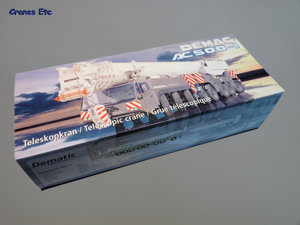 | | The box. | 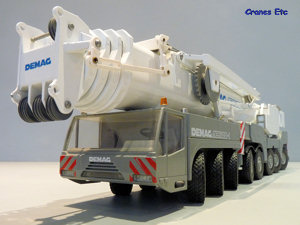 | | Heavy metal on the road. | 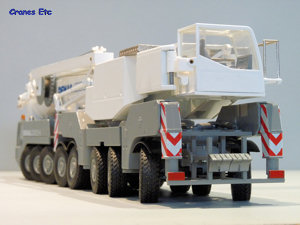 | | Steering range is good. |  | 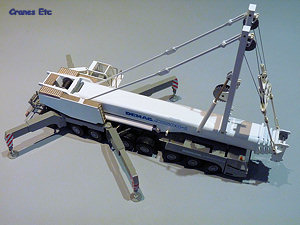 | | Outriggers out and superlift raised. | 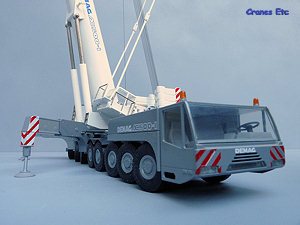 | | Smart cab. | 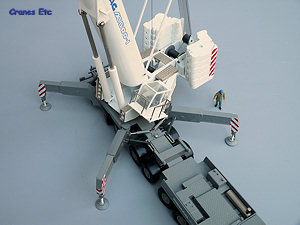 | | Star configuration outriggers. | 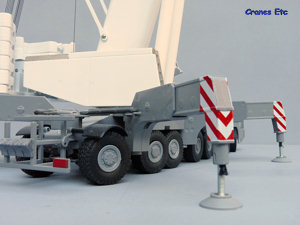 | | Outrigger screws are two thin for loads on the model. Thread is inserted into the piston to stop the screw slipping. | 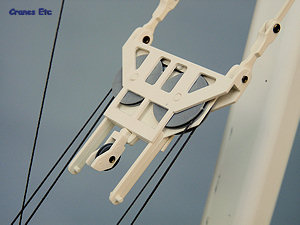 | | Luffing bridle. |
| The AC500-1 is an eight axle crane with a capacity of 500 metric tonnes. To see photos of the real machine click here.
Packaging
The model comes in a relatively large box with a picture sleeve. Inside, the model is securely packed within a pair of polystyrene trays. Instructions are provided which describe how to string up the Superlift. The review model was undamaged.
Detail
The size of the model immediately impresses, as does its weight.
The driving cab is well detailed internally although the steering wheel appears to sit a little high. There are no door mirrors or windscreen wipers on the model although a couple of orange beacon lights are present on the roof and there are headlights. The model also lacks a loop on the front for fixing the hook during transport. Moving back from the cab the carrier body is modelled well with exhaust and other details.
Over the fourth axle there are a couple of holes in the main spine beam and into this fits a special piece which holds the counterweight tray during loading and unloading. Mud guards are provided for axles 4, 5 and 8. At the rear an excellent piece of model frame work contains the wheel chocks and rear lighting cluster, which has the lights painted on.
The outrigger beams are very impressive being two-stage metal. Each folds out and is retained horizontally by a small hydraulic cylinder and retaining rod fixed into its own slide rail. The outriggers themselves are of the typical screw thread type, with a separate plastic pad for each one. The whole arrangement looks very good particularly as there are small details cast within the outrigger beams.
The crane cab is similarly well detailed internally and has excellent external handrailing. The rest of the crane body continues the high standard with good detailing at the rear including pipe and frame work. A couple of ladders are fixed to the front and top surfaces have non-slip walking plates. The counterweight tray is one solid piece containing space for the luffing winch. Although the pulley block is provided on the tray, the luffing winch is provided in the optional luffing jib kit. The counterweight tray poses perfectly on the carrier body for loading / unloading, or is fixed to the crane body by means of a couple of pins. A word of warning is that the plastic pins provided are slightly too small so they can easily work loose causing the tray to become detached. The counterweights supplied consist of five left and five right handed blocks. Each looks excellent complete with lifting lugs and graphics.
The boom is a five stage telescope of heavy and impressive construction with the usual internal locking mechanism to stop the sections sliding when fully extended. The boom head has a large number of pulleys together with the lugs for attaching the fly jib. The Superlift mechanism is well made with most parts metal including the tie bars. Only the connections to the boom head are plastic, presumably to keep the weight down. In transport mode the tie bars fold onto lugs fixed to the main boom and the bridle at the boom head clips into position.
The hook supplied with the model is a metal single pulley version and this does not do the rest of the model justice.
Features
The axles are linked for steering. The front five axles are linked and steer proportionally, with the fifth axle moving very little, and the rear three axles also steer proportionally. The steering on this model works very well and looks excellent when posed. The outriggers are fully working but it is here that there is a problem. The loads on the outriggers can get large particularly if the optional fly jib is attached and the screw jacks are simply not man enough for the job. It is all too easy to strip the thread from the screws rendering the outrigger useless for the model's stability. There is a work around for this problem however which is to remove the screw completely, insert some lengths of cotton into the screw hole and re-insert the screw. This has the effect of forcing the screw to 'bite' and the model has been found to be stable like this even with all wheels off the ground, as in the real machine.
The crane cab is fixed onto a mechanism which allows both tilt and the rotation from the transport to the operational position.
The boom is raised using two very large cylinders which are extremely stiff. They hold the boom very well, even with the fly jib, but it takes an act of courage to apply the force to the model needed to extend the cylinders. The Superlift is fully working, but needs to be wound up tight to remove any differential slack within the tie bars connected to the base of the jib. The hook can be operated by turning the winch drum directly with a finger. Although this avoids unsightly turning handles it does make the operation laborious. Having said that this is a model for showing in very impressive poses rather than playing with.
Quality
This is a high quality crane model which is every bit as impressive as the real machine. The paintwork is good as are the graphics, although on the review machine some of the graphics work was not perfect. Detailing in all aspects of the crane function is very good with the model only coming up slightly short in some areas such as mirrors and wipers.
Price
The AC500-1 is a relatively costly model although it is extremely impressive and is one of those models that delights non-collectors. It is good value for the detail offered.
Overall
This model is one of the best looking crane models. It can be posed in a large number of ways, and this can be expanded even further with the optional luffing fly jib which extends the model to a jaw-dropping almost 3m in height. Even despite the design flaw in the outriggers the model is recommended.
Footnotes
The model was introduced in 2001. The initial version of this model was produced in Demag white prior to the takeover by Terex. A luffing jib was available as a separate accessory. The model was revised later with a modernised superlift arrangement as Conrad 2098. |
| |
| 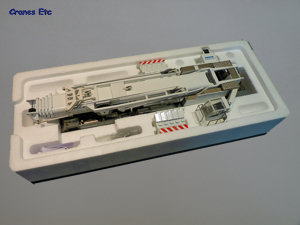 | | The model in the tray. | 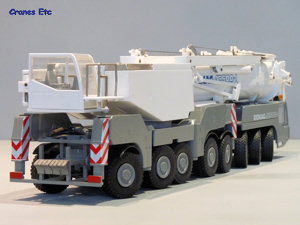 | | Cab tucked in behind when travelling. | 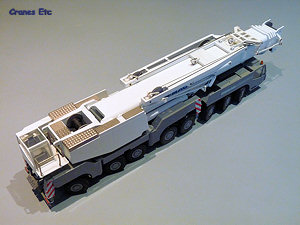 | | All neatly packed when on the road. | 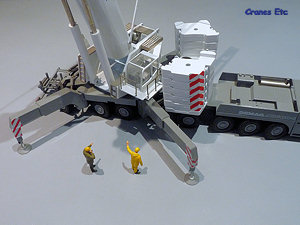 | | Loading up the counterweight. | 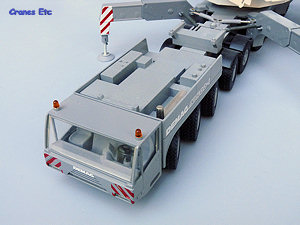 | | Detail behind the cab. | 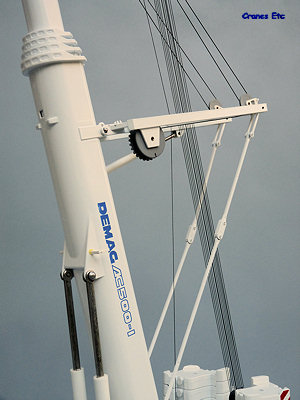 | | Superlift extended. | 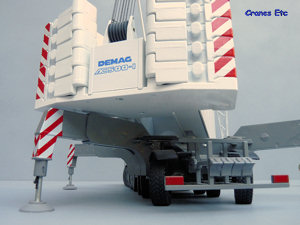 | | Counterweight tray. |
|

